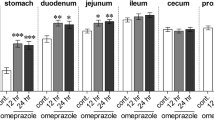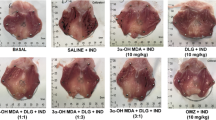Abstract
The present study was undertaken in rats using 2-deoxy-D-glucose (2DG) as a stimulator of gastric motility and a low dose of indomethacin as a prostaglandin (PG) synthesis inhibitor to investigate the roles of gastric motility and PG deficiency in the pathogenesis of indomethacin-induced gastric lesions. Subcutaneously administered indomethacin at 5 mg/kg did not induce any visible damage in the mucosa within 4 hr, but at 25 mg/kg produced linear hemorrhagic lesions along the long axis of the stomach. 2DG (100 mg/kg/hr), given intravenously, produced linear nonhemorrhagic lesions along the mucosal folds and, in the presence of 5 mg/kg of indomethacin, caused severe hemorrhagic lesions in the same areas of the stomach. Gastric motility was markedly enhanced by both indomethacin (25 mg/kg) and 2DG, while acid output and mucosal blood flow were increased only by the latter. Mucosal PGE 2 levels were significantly reduced by indomethacin (25 mg/kg) but not by 2DG. Indomethacin at 5 mg/kg alone had no or little effect on any parameter except PG levels, which were reduced to similar degrees as caused by 25 mg/kg of the agent. Time-course development of the lesions was closely associated with those changes in gastric motility after administration of indomethacin (25 mg/kg) and 2DG. These results suggest that the enhanced gastric motility is, by itself, sufficient to induce damage (nonhemorrhagic) in the mucosa and that a PG deficiency alone does not induce any damage but is required for further extension to hemorrhagic lesions of nonhemorrhagic ones that are initially induced by enhanced gastric motility.
Similar content being viewed by others
References
Djahanguiri B: The production of acute gastric ulceration by indomethacin in the rat. Scand J Gastroenterol 4:265–267, 1969
Robert A: Prostaglandins and the gastrointestinal tract.In Physiology of the Gastrointestinal Tract. Edited by LR Johnson, J Cristensen, MI Grossman, ED Jacobson, SG Shultz (eds). Raven Press, New York, 1981, pp 1407–1434
Lanza FL: Endoscopic studies of gastric and duodenal injury after the use of ibuprofen, aspirin, and other nonsteroidal antiinflammatory agents. Am J Med 13:19–24, 1984
Whittle BJR: Temporal relationship between cyclooxygenase inhibition, as measured by prostacyclin biosynthesis, and the gastrointestinal damage induced by indomethacin in the rat. Gastroenterology 80:94–98, 1981
Takeuchi K, Ueki S, Okabe S: Importance of gastric motility in the pathogenesis of indomethacin-induced gastric lesions in rats. Dig Dis Sci 31:1114–1121, 1986
Arai I, Hirose H, Muramatsu M, Okuyama S, Aihara H: Possible involvement of non-steroidal antiinflammatory drugs in vagal-mediated gastric acid secretion in rats. Jpn J Pharmacol 37:91–99, 1985
Mersereau WA, Hinchey EJ: Prevention of indomethacin-induced gastric hypercontractility; a mucosal protective mechanism of prostaglandin E2. Gastroenterology 78:1221, 1980 (abstract)
Ueki S, Takeuchi K, Okabe S: Gastric motility is an important factor in pathogenesis of indomethacin-induced gastric mucosal lesions in rats. Dig Dis Sci 33:209–216, 1988
Jacobson ED, Linford RH, Grossman MI: Gastric secretion in relation to mucosal blood flow studied by a clearance technique. J Clin Invest 45:1–13, 1966
Hayase M, Takeuchi K: Gastric acid secretion and lesion formation in rats during water-immersion stress. Dig Dis Sci 31:166–171, 1986
Brodie BB, Axelrod J: The fate of aminopyrine (pyramidon) in man and methods for the estimation of aminopyrine and its metabolites in biological materials. J Pharmacol Exp Ther 90:171–174, 1950
Arakawa T, Nakamura H, Chono S, Yamada H, Kobayashi K: Prostaglandin E2 in the rat gastric mucosa (first report); establishment of assay procedure and effects of nonsteroidal anti-inflammatory compounds. Jpn J Gastroenterol 77:8–15, 1980
Orcyk GP, Berhrnam HR: Ovulation blockade by aspirin or indomethacin;in vivo evidence for a role of prostaglandins in gonadotrophin secretion. Prostaglandins 1:3–20, 1972
Dunnett CW: A multiple comparison procedure for comparing several treatments with a control. Am J Stat Assoc 50:1096–1121, 1955
Whittle BJR, Higgs GA, Eakins KE, Moncada S, Vane JR: Selective inhibition of prostaglandin production in inflammatory exudates and gastric mucosa. Nature 284:271–273, 1980
Takeuchi K, Nishiwaki H, Osano H, Ebara S, Okabe S: The increased microvascular permeability on the rugal crests due to enhanced gastric motility in the rat stomach. Gastroenterology 94:A-453, 1988 (abstract)
Ohno T, Uramoto H, Ishihara T, Okabe S: Effects of 16,16-dimethyl prostaglandin E2 on surface epithelial cell damage in the rat stomach induced by vagal nerve stimulation. Jpn J Pharmacol 43:429–439, 1987
Van Kolfschoften AA, Hagelen F, Hillen FC, Jager LP, Zandberg P, Van Noordwijk J: Protective effects of prostaglandins against ulcerogenic activity of indomethacin during different stages of erosion development in rat stomach; role of acid and bicarbonate secretion. Dig Dis Sci 28:1127–1132, 1983
Main IMH, Whittle BJR: Investigation of the vasodilator and antisecretory role of prostaglandins in the rat gastric mucosa by use of nonsteroidal antiinflammatory drugs. Br J Pharmacol 53:217–224, 1975
Cheung LY, Lowry SF: Effect of prostaglandin E2 (PGE2) and 16,16-dimethyl PGE2 (DMPGE2) on gastric acid secretion and blood flow. Gastroenterology 70:870, 1976 (abstract)
Cheung LY, Chang N: The role of gastric mucosal blood flow and H+ back-diffusion in the pathogenesis of acute gastric erosions. J Surg Res 22:356–361, 1977
Kivilaakso E, From D, Silen W: Relationship between ulceration and intraluminal pH of gastric mucosa during hemorrhagic shock. Surgery 83:70–78, 1981
Author information
Authors and Affiliations
Rights and permissions
About this article
Cite this article
Okada, M., Niida, H., Takeuchi, K. et al. Role of prostaglandin deficiency in pathogenetic mechanism of gastric lesions induced by indomethacin in rats. Digest Dis Sci 34, 694–702 (1989). https://doi.org/10.1007/BF01540340
Received:
Revised:
Accepted:
Issue Date:
DOI: https://doi.org/10.1007/BF01540340




